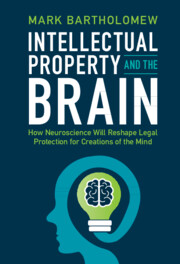 Intellectual Property and the Brain
Intellectual Property and the Brain Book contents
- Intellectual Property and the Brain
- Intellectual Property and the Brain
- Copyright page
- Contents
- List of Figures
- Acknowledgments
- Introduction
- Part I The Law and Neuroscience of Creative Activity
- Part II Understanding Audiences for Art and Advertising
- 3 Neuroaesthetics and Copyright Infringement
- 4 Seeing Design
- 5 Neuromarks
- Part III Using Neuroscience to Improve Intellectual Property Law
- Index
5 - Neuromarks
from Part II - Understanding Audiences for Art and Advertising
Published online by Cambridge University Press: 14 July 2022
- Intellectual Property and the Brain
- Intellectual Property and the Brain
- Copyright page
- Contents
- List of Figures
- Acknowledgments
- Introduction
- Part I The Law and Neuroscience of Creative Activity
- Part II Understanding Audiences for Art and Advertising
- 3 Neuroaesthetics and Copyright Infringement
- 4 Seeing Design
- 5 Neuromarks
- Part III Using Neuroscience to Improve Intellectual Property Law
- Index
Summary
The touchstone of any trademark lawsuit is the likelihood of consumer confusion. Courts calculate this likelihood through a series of notoriously unreliable proxies, lamenting that their effort to understand the consumer must be a “shaky kind of guess.” Through the burgeoning field of consumer neuroscience, scientists can now determine when a subject is thinking about one brand versus another. Take, for example, recent research measuring changes in brain blood flow and oxygenation while subjects viewed several well-known trademarks. According to the researchers, each trademark has a different neural signature, with different brain regions reflecting perceptions like “excitement,” “ruggedness,” or “sophistication” upon exposure to the brand stimulus. By viewing these neural signatures and nothing else, researchers could distinguish whether the subject was thinking about Apple or Microsoft, Coke or Pepsi. Studies like this hint at a near future where fMRI readings replace today’s judicial guesswork about consumer perception.
Information
- Type
- Chapter
- Information
- Intellectual Property and the BrainHow Neuroscience Will Reshape Legal Protection for Creations of the Mind, pp. 102 - 124Publisher: Cambridge University PressPrint publication year: 2022